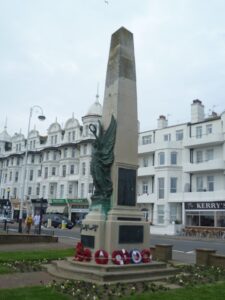The commemoration of the First World War began during the War itself and was not always associated with death. Rolls of Honour listing the men who had gone to war were put up by businesses and churches to celebrate their bravery and to encourage other men to enlist. Rolls were also published in local newspapers listing all the local men who had enlisted as well as the growing list of the dead, and the missing.
The day the War was declared, the 4th August, became a day of commemoration and became known as Remembrance Day during the war. Churches would also hold regular memorial services to remember all those serving at the Front as well as those who had died which provided vital support for the families at home.
Following the end of the War, the Government were keen to control how the war was remembered to justify the deaths and to provide meaning for the men’s sacrifice. They did not want the British public questioning the war, and in turn questioning the government who had taken them to war. Above all else they feared revolution as other European countries suffered rioting and revolts following the Armistice. In order to do this, numerous commemorative traditions were invented including the creation of Armistice Day on the 11th November, the two minutes silence, poppy wearing, annual commemorative ceremonies at the Cenotaph and the Tomb of the Unknown Warrior in London, pilgrimages to the war cemeteries and ceremonies at local war memorials.
Local War Memorials

Although some towns had begun creating memorials before the end of the War, from 1919 onwards villages and towns across the country began erecting war memorials en masse. They could choose between traditional monuments such as obelisks, crosses and tombs or a more useful utilitarian memorial such as recreational halls and sports grounds, hospitals, and endowments. These were usually created by either parish councils or specially formed War Memorial Committees working on behalf of the local community, and were paid for by donations from the public, councils and local landowners. For the towns who chose a traditional monument it was often the engraving of the names of the fallen which held the most importance and allowed communities to symbolically bring their dead home, transforming memorials into mass gravestones.
In Bexhill the earliest First World War memorial is located in St. Barnabas Church and was unveiled in 1917 during the War. Following the Armistice other churches and local businesses such as Lloyds Bank and the Post Office also began to erect War Memorials to the fallen from their local parishes and staff. In November 1919 the Peace Memorial outside St. Mary Magdalene’s Church which had been designed by the Mayor Alderman G.H Gray was also unveiled.
Bexhill Town War Memorial
Discussions about a town war memorial began in March 1919 and were met with little enthusiasm from the local residents, who seemed more interested in celebrating the Peace than commemorating the fallen. Despite this lack of support a War Memorial Committee was formed to manage the creation of a memorial which included the Mayor and Deputy Mayor, local councillors and clergy, retired military officers and a small number of the bereaved. Sub-committees were formed to investigate various aspects of the memorial such as the different commemorative schemes, location, funding and design.
Various suggestions were put forward for the type of memorial with the majority of Bexhillians favouring utilitarian schemes such as a recreational facility for the returned soldiers, a cottage hospital, a guildhall which would include a small museum, art gallery, reading room and a free library, scholarships for the children of the town’s war dead, the building of cottages to house the widows and children of the fallen and a Bexhill Ward in the new East Sussex Hospital that was being re-built in Hastings. Those who supported a more traditional memorial suggested schemes which included a Market Cross in front of the Town Hall inscribed with all the names of the fallen and the names of all the Bexhill Men who served to be inscribed on oak panels on the interiors walls of the Town Hall.

The eventual decision was for both a traditional monument inscribed with the names of Bexhill’s war dead and a utilitarian memorial in the form of a fund for the children of the Bexhill men who had died during the war to pay for education, apprenticeships and clothing for entering employment. The traditional monument was a 28 feet high stone obelisk designed by sculptor F.L Roslyn R.B.S. and is situated at the bottom of Sea Road on the seafront. It has bronze plaques which are engraved with the names of the fallen and a bronze figure of Victory grasping a sword which looks out across the sea towards the Western Front. Both memorials were funded by public donations to a Memorial Fund. Roslyn’s traditional memorial cost £1,400, approximately £60,200 in today’s money.
The Memorial was unveiled on the 12th December 1920 in a ceremony organised by the War Memorial Committee. It began with a procession from the Town Hall to Sea Road, via Station Road. The procession included over 750 people including relatives of the fallen at the front, ex-serviceman and veterans, serving armed forces, Sussex VADs, Red Cross Men and Women, Scouts, Girl Guides, the Mayor, Officers, Councillors, local Clergy and the Memorial Committee. The ceremony included hymns and blessings from the local clergy before the memorial was officially unveiled by Brigadier General O’Donnell. After a short speech a 19 gun salute was fired and the Last Post was sounded followed by 2 minutes silence. Finally, the Committee officially handed over the Memorial to the Mayor and floral tributes were laid.
After 1945 the names of the fallen from the Second World War were also added to the memorial.

